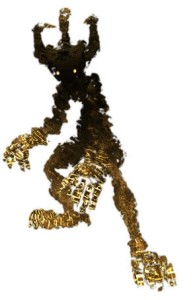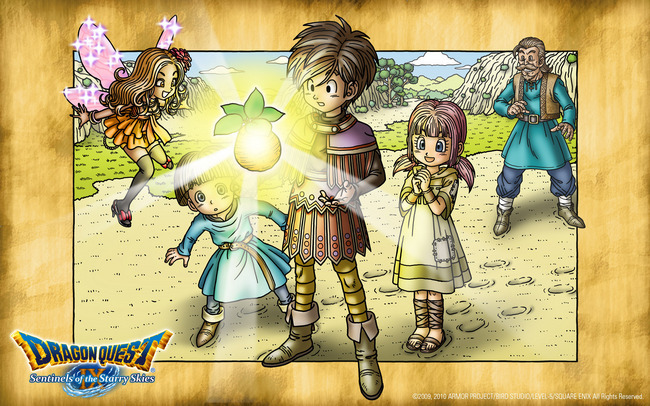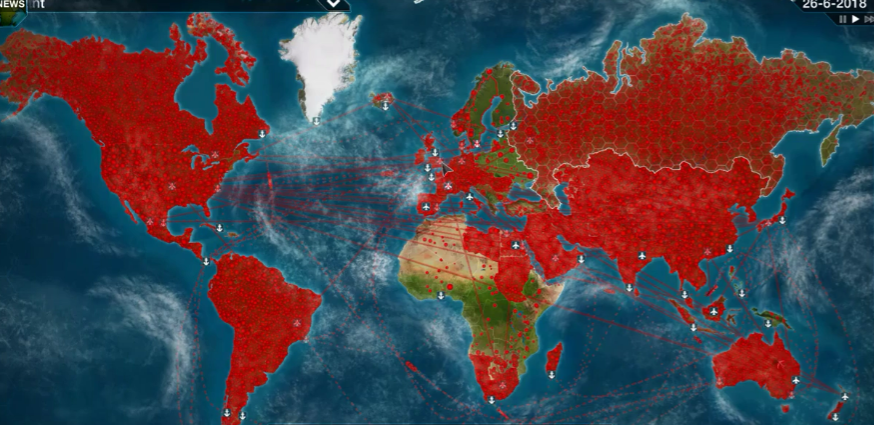I’m never quite sure who decides which games should get sequels, and why. But, if you had told me three years ago that NieR: Gestalt and Replicant was going to get a sequel, my initial comment would have been someone else played that game?
NieR: Gestalt and Replicant (Square Enix) came out in 2010. I remember seeing the commercials on G4 back when the gaming channel still showed video games. And then, I didn’t see anything about it–hell, I couldn’t even find the game–until I started dating my partner. He liked the soundtrack, and so he’d bought the game in 2012.
I entered, stage left, in 2014, and promptly told him that I thought he owned a game that didn’t actually exist. Since that conversation, we’ve collectively played the game through 7 times–my partner 3 times before we met, and us together 4 times.
Having gone through it that much, it’s no surprise that this game wasn’t a best seller. It’s unfinished. Obviously unfinished. You explore 9 locations so thoroughly in one playthrough that you can navigate them in your sleep (one of those 9 locations is literally only white text on black screen). The combat system was fun, but way too easy. I don’t know what the game over screen looks like. Most of the mechanics seem like an afterthought. Like they wrote a story and then remembered it was a game, not a novel. You can see–literally see–where the budget ran out.
NieR is a sequel to Drakenguard. Specifically, a sequel to Drakenguard’s hardest to-get-ending. Something I didn’t realize until I looked something up on Wikipedia about it. I guess that explains the five sisters and white dragons thing that came up once. And basically all the weapon lore.
There are two versions: the North American release NieR: Gestalt, which stars “Father Nier”, and the Japanese release NieR: Replicant, which stars “Brother Nier”. I played Gestalt, and still wonder if the story feels different and takes on different meaning depending on if you are Brother or Father. I bet it does.
Since NieR is getting a sequel, in the form of NeiR: Autamata, I’m over here trying to decide if I’m happy about that or ready for the emotional olympics it’s going to drag me through again, I wanted to talk about why I stuck through this strangely unfinished but somehow solid game so many times.
Specifically, I want to talk about how this game addresses Right and Wrong. And why there are no right answers.
Of course, I can’t do that without spoiling literally everything about it, so if you’re going to play it any time soon, avoid the rest of this post. Seriously.
Also, to all those who played this game enough to warrant DLC and a sequel, I commend you. Please come out of the woodwork, we have much to discuss.
—
I believe wrong and right come in flavors: Objective Right/Wrong, Subjective Right/Wrong, and Moral Right/Wrong.
Objective Right and Wrong is proven by fact. It can be backed up with data, and has a clear boundary between correct and false. For example: Water in its purest form has the chemical formula of H2O. This is an objectively right statement as data has shown so far. Changing the chemical formula changes the compound
Subjective Right and Wrong is based on personal feelings or opinions. While this can stem from an Objective wrong or right, it typically is skewed by personal preference or experience. For example: Cheesecake is the best dessert. While I may believe that, others may find cheesecake disgusting.
Moral Right and Wrong is based off of a person’s principles. These come from religion, family, culture, and other influences. This is the discussion of Good and Bad, and though it is subjective in nature, it typically goes further than opinions and falls into a belief system. For example: I believe killing, in all cases, is wrong. There are many people who will debate with me to say when it should be alright to kill someone (in the case of the death penalty or wartime killings).
Moral Wrong and Subjective Wrong are typically the stem of all arguments on the internet. That, or Objective Wrongs that have been skewed into Subjective Rights (Vaccines don’t cause autism, objectively, but we still have the Anti-Vaxxer movement, for example).
What’s this got to do with the unfinished mess that is NieR?
NieR is a lot like arguing on the internet. No one is right.
—

I didn’t think anything of the Shades–the “unquestionably bad creatures”–until I faced off against one that didn’t fight back. One that was far more interested in books than anything else. After having to kill it (them?) to progress the plot, I started to question what we were fighting. Nier didn’t have a problem killing the Shade. He didn’t have a problem killing every Shade that ever existed (and he says so, often). Shades, to him, are the cause of everything that went wrong.
Of course, I’m one step removed, and I’m trying to figure out why that one in that library was just wandering around, reading.
My partner always says that games take a “they started it” approach to justify bad guys, at least to start out. You’re justified in fighting monsters because the monsters attacked you. Typically, that’s enough to carry you over until the “real” reason you’re fighting is revealed.
In the first half of the game, Nier fights Shades. That’s basically his job description. Fight Shades, do errands, find a cure for the mysterious disease his daughter has. By fighting Shades. In the second half, Nier fights Shades. Shades have taken his daughter, Yonah. So he’s going to kill them all.
That’s really all the justification you need for this half-finished hack and slash RPG.
But not quite.
Okay, honestly, there were a lot more things that pissed me off than just killing Shades without a good reason (for example, what happened to Fyra). But when I started to realize what exactly was wrong didn’t happen till the first ending and after.
LAST CHANCE TO AVOID SPOILERS. SERIOUSLY I WARNED YOU.
See, no one was surprised that the last boss is the Shadowlord. And honestly, after playing as many JRPGs as I have, seeing the Shadowlord was Nier wasn’t too surprising really.
What the horrible realization was, at first, the Shadowlord was fighting for the daughter too. Because Yonah was his daughter too. Because the Shadowlord was the Shade of Nier. So the Shadowlord was just trying to keep her safe too. And he dies hoping Nier will keep her safe because he’s quite aware that if he would fail, Nier has every capacity to as well.
Yeah I thought that was pretty bad.
“No no,” are the famous words of my partner. “It gets worse.”
He’s right. Because the second playthrough, the Shades talk. And the Shades were people, basically souls that have lost their bodies and manifested in different ways. (I know, very Kingdom Hearts-esq.) But the Shades have been trying to live and avoid humans now because humans just kill them every time they encounter each other.
So we have Shades who drop balls and coloring books and oh dear lord I’m killing children and families and literally using the blood of the dead to power magic…

In the final level, there is a ball. The first time you run through, it looks like a room of never ending enemies. The second, third, and fourth times, you realize it’s a room full of the last Shades who are trying to protect their children in the next room.
This game got very hard to play emotionally.
—
More and more, this game reveals that maybe Nier’s actions weren’t justified. At first, it seems like an Objective problem. Bad guys (Shades) attack Nier and he fights back. Subjectively, you could have a problem with this or not, depending on how you look at hack and slashes.
The moral problem of Nier is that neither side, presented in the game’s world, is right. Because they’re both fighting for the same thing. Safety. A place to live. Verified existence. Unfortunately that leads the two sides to be fighting to extinct the other.
But I need to repeat: both sides are fighting for the same thing. Both sides are justified in their beliefs. However, it’s the means to the end that put their thoughts in question.
This is why this game is “fighting on the internet”. Regardless of which side is “Right” or “Wrong,” they both believe their opinion so strongly that sometimes they’ll do anything to support it. And often, the anonymity of the screen between them and the other person makes it impossible to see it from any other angle.
Nier can’t.
—
We spoke last week, and have spoken before, about Otherness. I didn’t mention it at the podcast–there was much to discuss–but Nier was the first game I actually thought of for a good example of this.
It happens so much in the game. So much that I feel it was done on purpose to show how dangerous Otherness is. The Wolves vs Facade. Kaine vs the People of the Aerie. Gideon vs the Robots of the Junkheap. Nier vs the Shadowlord. Every time, a choice is made on who the “Bad Guy” is. But it’s up to the player to see that maybe the bad guy isn’t so bad. It all depends on who’s view you’re looking through.
The game acknowledges Otherness and makes the characters acknowledge it on two notable occasions. Regardless of the extrospection.
The first is with Facade. Nier and his friends are the Other this time. They do not know the Rules. They do not have masks. The only reason they’re even allowed in to the society is because Kaine saved Fyra a long time ago, so Fyra can serve as their guide and talks for them in sign language.
Of course, the characters routinely talk about how dumb it is that people won’t even talk to them because they are outsiders. And they aren’t viewed as anything less until they save the King. And then suddenly they’re allowed to be seen and spoken too and are no longer Other.
They had to assimilate. Not always a possible course of action in real life, and even the game acknowledges this by the shear feat Nier must undergo just to save the King.
The second point occurs late in the game. Third and Fourth ending late.
When Nier works with a Shade to save Kaine.
It seems like a total flip in character. And having gone through three full playthroughs of the game, seems like out of left field. But finally, Nier breaks the Otherness and…
No, I’m lying. Nier still sees the Shades as Other. Unfortunately, he never stops that. But he does make it to the point that he realizes that he can’t just kill them all and save the world. That won’t save Kaine or Yonah or anyone. But, to be honest, I’m not sure erasing his existence saved anyone either. But the fact that he made it to the point that he’d let a Shade live and kill himself instead…Maybe he was starting to see the other point of view.
—
The extrospection of Nier is easier to see than the introspection, because if you wait for the game to point out how convoluted and messy the argument for either side is, you’ve had to play through four times. And it still has the holes of a game unfinished.
But I’d argue that, from the outside, it’s easy to see what issues Nier brought to the table. That, when fighting a war on morals, it’s hard to find who’s right and wrong, especially when both sides are killing each other. That when “othering” a group of people, you can no longer see things from their point of view, and (sometimes quite literally) reduce them to monsters.
And, ultimately, the greatest sacrifice might not fix a damn thing.
With all of this raised from this game alone, I’m terrified of what we’ll face in NieR: Automata. After all, that game has a budget.





